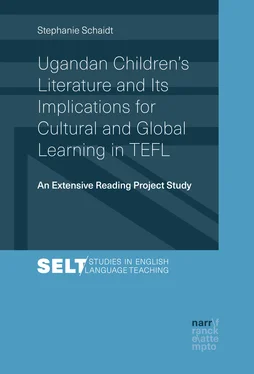The selection of participants for the study had to be carried out at different stages of the research project. As a first step, the school level at which the research project was conducted had to be chosen. Until then, the majority of empirical studies that looked into literature and cultural learning in the EFL classroom had worked with higher grades of secondary school (Fäcke, 2006; Freitag-Hild, 2010a). In order to widen the scope of research in this field, I therefore intended to focus on lower or intermediate levels of secondary school. The linguistic level of the majority of books and stories from Uganda that were available and considered as suitable (see Chapter 4.1 and 4.4) required that the students participating in the study had an elementary or threshold level of English language proficiency (A2-B1). Therefore, Year 9 of grammar school ( Gymnasium ) was selected as the sample group. Secondly, the classes participating in the research project had to be chosen. In this context, personal contacts to schools on my part as the researcher played an important role (see Chapter 5.5). Of the two schools that participated in the research project, school A is located in a small town1 in Baden-Württemberg and school B in a city2 in Bavaria. Furthermore, it is interesting to note that school A maintains an educational partnership with a school in Uganda which involves penfriend correspondence, regular fundraising activities and volunteer stays in Uganda. The students from this school could, therefore, be expected to have already come into contact with the country Uganda within the framework of the partnership. School B, however, does not have a partner school in a country of the Global South. There were also eight students ‘with a migration background’3 among the students participating in my study. This was considered important, since previous studies (Burwitz-Melzer, 2003, p. 137; Fäcke, 2006, p. 213) had shown that students who were raised biculturally reacted differently to the literary texts than those who were raised monoculturally.
The majority of the 49 students of the two Year 9 forms, in which the reading project was conducted, could be motivated to take part in the study. Only four students did not give their permission for the analysis of their responses. Thus, the research project was conducted with 45 Year 9 students, 23 girls and 22 boys, who got engaged to a different extent in the study. One student read 14 novels and short stories, two students, on the other hand, did not read any of the texts provided. Some students wrote very long reading diary entries, others only very short, fragmented sentences. From these 45 students participating in the study, 24 were additionally interviewed. These cases were selected by the criterion of maximum variation. In maximum variation sampling “samples are chosen that possess or exhibit a very wide range of characteristics or behaviours respectively, in connection with a particular issue” (Cohen et al., 2011, p. 157). Students with various biographical backgrounds (e.g. students ‘with’ and ‘without a migration background’), diverse types of reading socialisation (e.g. experienced and less experienced readers) and distinct responses to the literary texts (e.g. rather positive and rather negative reactions) were, therefore, chosen for the interviews. Some students, however, did not want to participate in the interviews and thus they could not be selected. Others, who were not chosen for the interviews in the first place, explicitly expressed the wish to be interviewed. To acknowledge their willingness and so as not to demotivate them, interviews were also conducted with these students. Thus, volunteer sampling (Cohen et al., 2011, p. 160) also played an important role here. Finally, twelve students were chosen for an in-depth case analysis (see Chapter 6.1). Also here, the criterion of maximum variation was applied in order to consider a wide spectrum of reactions and ways of dealing with literary texts (see Fäcke, 2006, p. 83; Küppers, 1999, pp. 134–135).
Within the framework of qualitative inquiry strategy, triangulation between methods (Denzin, 1970) was applied in this study. As Cohen et al. (2011, p. 197) note “[t]riangulation between methods involves the use of more than one method in the pursuit of a given objective”. In the case of my research project, I made use of three different data collection methods: survey studies, diary studies and interviews. This approach of combining various research instruments provides a means of checking validity as it adds other perspectives on the issue and thus gives a deeper insight into the subject matter (Flick, 2014, p. 184). In the next section, the three different data collection methods that were used in my study are presented along with reasons for their selection and challenges they entail.
A semi-structured questionnaire with mainly open items was used at the beginning and at the end of the reading project. According to Cohen, Manion et al. (2011, p. 382), “[t]here is a clear structure, sequence, focus” in semi-structured questionnaires “but the format is open-ended, enabling respondents to reply in their own terms”.
In my study, the number of open questions predominated because the research project does not primarily aim at measurement and generalisation but at the perspectives of individual cases. Only socio-demographic data were collected through closed questions, and strength of response (e.g. to what degree they enjoyed reading) was indicated by the students on Likert scales. The responses to these items were later statistically analysed and compared across participants.
Open questions permit free, individual answers and do not limit the participants in their responses by means of pre-set categories. Thus, they may provide the researcher with comparatively deep answers. As Cohen et al. (2011, p. 392) note, “an open-ended question can catch the authenticity, richness, depth of response, honesty and candour which […] are the hallmarks of qualitative data”. It has to be acknowledged, however, that the open character of questions can also overstrain the respondents because writing down their answers requires time and reflection. Another challenge posed by questionnaires with open questions is that the qualitative nature of the data makes comparison between respondents difficult and, therefore, the process of analysis complex (ibid., p. 382). Thus, open or word-based questionnaires are particularly suitable for smaller samples and for studies which require personal, individual comments (ibid., p. 392), as in the case of my research project.
In order to make sure that all the students understood the questions and were able to write down their responses, the questionnaires in my study were given in German. They were completed in silence in the classroom in my presence. This was helpful because uncertainties could be addressed immediately and it also ensured a good response rate. All 45 students who participated in the study completed the first questionnaire; only one student failed to hand in the final questionnaire because he was absent in the last lesson.
The first questionnaire (see Appendices A and B), which was completed before the reading project started, asked for students’ associations and expectations concerning Uganda and their interest in the country. The students were asked to write down their associations with Uganda, list a few sources for their information about African countries, name aspects concerning Uganda they are particularly interested in and state whether and why they would (not) participate in a student exchange with a Ugandan school. In addition, the questionnaire inquired after the reading preferences of the students and their expectations regarding Ugandan children’s fiction. The students were asked to what degree they enjoyed reading literary texts in German and English in their free time and for the frequency with which they read such texts in the two languages. Students were also questioned for topics/literary genres they are most and least interested in and asked for their expectations concerning Ugandan children’s fiction. Furthermore, socio-demographic data about the students were obtained through the first questionnaire. The students were asked for their sex, year of birth, age, nationality, their own/parents’ country of birth, the language they first learnt and the language spoken at home.
Читать дальше












